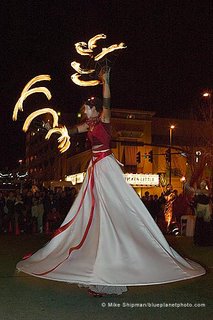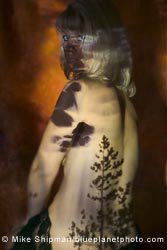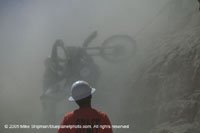
And The Angels Bled
Polaroid SX-70 manipulation by Mike Shipman
I knew it was inevitable. A 30-yr old film generally hanging on by a
thread from the beginning, in terms of its "flaw", then being
championed by artists all over the world, creating the market so
Polaroid would keep the "flaw" intact (for the most part) and artists
could exploit it for decades. Now, Polaroid has said they will end
production of Time Zero film in the first quarter of 2006.
You can read the notice below, which I lifted from the Polaroid website at
www.polaroid.com/sx70/en/index.html***
Please be advised that Polaroid will be discontinuing the manufacture
of its SX-70 / Time-Zero film within the first 3 months of 2006 due
to the phasing out of components used in the production of this film.
We realise that this is disappointing news for our loyal SX-70 users
and we would like to underline that, although the circumstances made
it inevitable, it was not an easy decision.
We are very sorry for the inconvenience.
For customers who would like to continue using their SX-70 camera, we
can offer some film alternatives below. However, we do appreciate
that these films do not offer the same characteristics as SX-70 /
Time-Zero film.
***
SX-70 film, now called Time Zero film, came out in 1972 with the Polaroid SX-70 Land Camera, a folding Polaroid that, for its day, was the most advanced camera on the market. The film had one "flaw". The emulsion did not harden as quickly as it was supposed to, allowing artists using various tools to push and smear the dye and base layers around to create impressionistic-looking, or "painterly" images. Sometimes called SX-70 manipulation (a long term), altered SX-70, painterly photography, or a variety of other terms, the essential description is that it is done by hand. Some people continue the process through digital manipulation or painting/drawing over the Mylar cover with oils, acrylics, or inks, or otherwise embellishing the image. I tend to prefer the straight altered image. I do scan the originals and enlarge them for printing, but I don't do any further manipulation.
Since the original film has depth (in that the emulsion is composed of several layers) the altered image also has depth, which can accentuate the feeling of depth in the image and also be apparent under certain lighting conditions and viewing angles. A print, although striking when enlarged, lacks this dimensional component.
Being only 3" x 3 1/8", the film has a small working area, so tools and timing are important in creating the effects desired. However, in reality you're not ever really sure what you'll end up with once you start bacause the work is done in real time, you create more or less on the fly. Environmental conditions, mental and emotional state, relationship to the subject, tools used, among others, all play a role in how the final piece turns out.

Blue
Polaroid SX-70 manipulation by Mike Shipman
The process starts once the exposure is made and the film is passed through the rollers, squeezing the developer across the film. The development can be arrested by putting the film at that point into the freezer, but I like working on the image "live", at the moment. I have a "toolkit" of manipulators that I carry with me, but I will also use found items on site. Sometimes, I will use only found items, then discard them once the image is done, thereby preserving the effect on the original.
I create 2 types of original SX-70 manipulation. By original I mean that the manipulations done are different for each image created, no two being the same. Much like 2 paintings of the same subject.
The first original is created with the Polaroid SX-70 camera. This results in a "true original" in that the image cannot generally be repeated. The image is shot with the camera, the film is processed on the spot following the exposure, and the manipulation of the image is done at that same point in time.
The second original is done using 35mm slide film and a slide printer (Daylab). For this I am using a 35mm transparency and exposing the SX-70 film with that image, similar to how a print is made in a darkroom using a negative and enlarger. The image is then altered after the film is exposed. In this case, several different original "versions" of the same image can be made; originals in that each separate image is manipulated using different techniques, pressures, emphasis, etc. Using the 35mm (now digital) camera allows for more flexibility in lens choice, lighting options, shooting conditions, etc. To effectively work the emulsion on the Polaroid film, the temperature of the film needs to be above 80 degrees (F), so wintertime manipulations are tricky at best. Enterprising artists have come up with ingenious mobile heating devices to allow for manipulations to be done in less than optimal conditions.
So, this art form will be disappearing (new creations anyway) in 2006. Unless another lab can replicate or purchase the "recipe" from Polaroid to continue production. I've been buying as much film as I can to build up my library of SX-70 work. I'll definitely miss it.
To see more of my SX-70 work, go to























